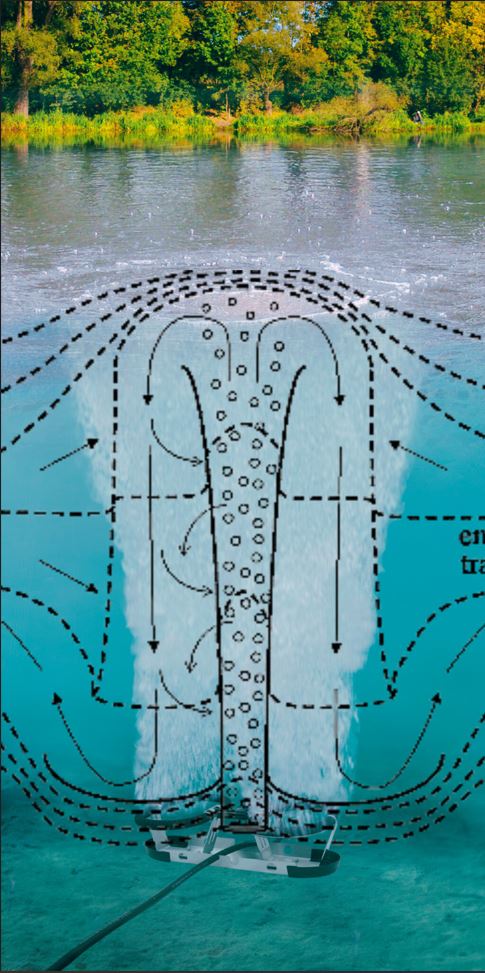It is a common misconception that the individual bubbles from a diffuser are transferring (dissolving) oxygen into the water. While it is true that the bubbles transfer between 1 to 3 % of their gas into the water per foot or rise, the majority of the oxygen transfer happens at the water's surface, where water comes into contact with the atmosphere. At this water/air interface, dissolved oxygen will reach an equilibrium with the atmosphere, we call this 100% saturation. The objective of a diffused aeration system is therefore not to dissolve gas into water, but rather to cause vertical lift of the water, moving bottom water that anoxic to the surface interface where the gas exchange occurs. To complicate matters, as the surface of a lake(called the epilimnion) heats up in spring and summer, the density of that water decreases. This results in the stratification of a lake which prevents mixing with the bottom layers (called the hypolimnion). A well designed diffused aeration system should take this stratification into account and result in near uniform dissolved oxygen and temperature throughout the entire water column. To properly size a system it is vital to know the strength of the seasonal stratification as well as the lake or pond's morphology (shape, area, topography, max depth, average depth, and volume). Having a bathymetric map commissioned is the best way to ensure your system design will be suitable.
Limitations: Diffused aeration is not effective in shallow lakes and ponds (<7'), or very deep lakes or ponds (>50').

The limitations of diffused aeration listed just above are why we often rely on updraft circulators (aka fountains). These are an ideal tool to move and circulate water in shallow waterbodies or in areas with isolated coves or dead zones. Choosing the right type of fountain (propeller vs impeller, horsepower, floating or fixed) is all dependent on the depths and shape of the lake. A moderately sized fountain can draw water up from 7' below the surface which in turn also creates horizontal water circulation. In some cases, fountains alone, or even in combination with diffusers, are not sufficient to meet the objectives of a project. Typically, this is the result of very shallow isolated shorelines or sections of a waterbody, such as where docks or other infrastructure inhibit currents and causes stagnation. In these situations, circulators are a useful tool to augment the movement of water. These are not traditionally considered aeration devices, however, if positioned strategically can disrupt stratification in localized areas and work as a downdraft circulator. Often people rely on these to prevent the accumulation of floating debris near their shoreline (algae mats, trash, floating plants or plant fragments, etc.).

Some lakes are more suited for oxygenation systems, that is, devices that are designed specifically to dissolve oxygen gas directly into the water. This approach has been used successfully for over 7 decades. Many lake managers rely on this approach to restoring dissolved oxygen (DO) levels without disrupting stratification, for restoring critical habitat, especially for cold-water fisheries, and for reducing internal loading of phosphorus. This last category of "aeration" gets very technical and we will not go too in depth here, only to say, significant research about your site would be required to implement many of these tools successfully. They are not something one would typically buy online. Be weary of emergent technologies, there are many unknowns with many of these devices, we know from personal experience, and often their are several significant drawbacks such as maintenance, cleaning, and routine recalibration. Always get a few opinions, especially from those who are not already ambassadors of the technology. Learn more about OST systems, click here
If you're not mapping you're not managing! In most cases it is impossible to design an effective aeration system without an accurate bathymetric map.

Contact us today to learn more about how our bathymetric surveying services and detailed mapped information can assist you in properly sizing your lake aeration system.
Request Consultation Today -->